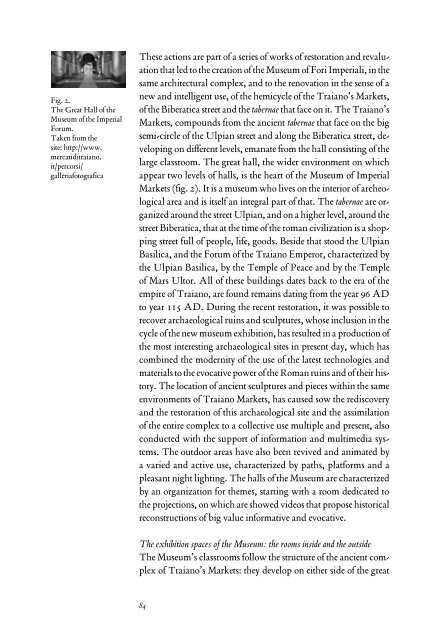Download ebook FREE - Allemandi
Download ebook FREE - Allemandi
Download ebook FREE - Allemandi
Create successful ePaper yourself
Turn your PDF publications into a flip-book with our unique Google optimized e-Paper software.
Fig. 2.<br />
The Great Hall of the<br />
Museum of the Imperial<br />
Forum.<br />
Taken from the<br />
site: http://www.<br />
mercatiditraiano.<br />
it/percorsi/<br />
galleriafotografica<br />
These actions are part of a series of works of restoration and revaluation<br />
that led to the creation of the Museum of Fori Imperiali, in the<br />
same architectural complex, and to the renovation in the sense of a<br />
new and intelligent use, of the hemicycle of the Traiano’s Markets,<br />
of the Biberatica street and the tabernae that face on it. The Traiano’s<br />
Markets, compounds from the ancient tabernae that face on the big<br />
semi-circle of the Ulpian street and along the Biberatica street, developing<br />
on different levels, emanate from the hall consisting of the<br />
large classroom. The great hall, the wider environment on which<br />
appear two levels of halls, is the heart of the Museum of Imperial<br />
Markets (fig. 2). It is a museum who lives on the interior of archeological<br />
area and is itself an integral part of that. The tabernae are organized<br />
around the street Ulpian, and on a higher level, around the<br />
street Biberatica, that at the time of the roman civilization is a shopping<br />
street full of people, life, goods. Beside that stood the Ulpian<br />
Basilica, and the Forum of the Traiano Emperor, characterized by<br />
the Ulpian Basilica, by the Temple of Peace and by the Temple<br />
of Mars Ultor. All of these buildings dates back to the era of the<br />
empire of Traiano, are found remains dating from the year 96 AD<br />
to year 115 AD. During the recent restoration, it was possible to<br />
recover archaeological ruins and sculptures, whose inclusion in the<br />
cycle of the new museum exhibition, has resulted in a production of<br />
the most interesting archaeological sites in present day, which has<br />
combined the modernity of the use of the latest technologies and<br />
materials to the evocative power of the Roman ruins and of their history.<br />
The location of ancient sculptures and pieces within the same<br />
environments of Traiano Markets, has caused sow the rediscovery<br />
and the restoration of this archaeological site and the assimilation<br />
of the entire complex to a collective use multiple and present, also<br />
conducted with the support of information and multimedia systems.<br />
The outdoor areas have also been revived and animated by<br />
a varied and active use, characterized by paths, platforms and a<br />
pleasant night lighting. The halls of the Museum are characterized<br />
by an organization for themes, starting with a room dedicated to<br />
the projections, on which are showed videos that propose historical<br />
reconstructions of big value informative and evocative.<br />
The exhibition spaces of the Museum: the rooms inside and the outside<br />
The Museum’s classrooms follow the structure of the ancient complex<br />
of Traiano’s Markets: they develop on either side of the great<br />
84







